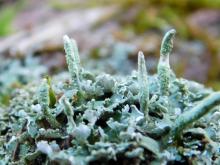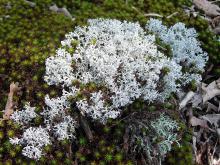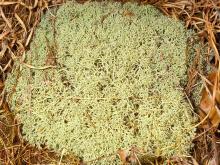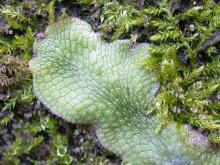Mosses, Liverworts, and Lichens
Media

Species Types
Scientific Name
Cladonia cristatella
Description
British soldier lichen is widespread in eastern North America. Branching stalks with bright red knobs at their tips arise from a patch of small, green scalelike structures. The red is similar to the color of British soldiers’ coats during the American Revolution.
Media

Species Types
Scientific Name
Cladonia coniocraea
Description
Common powderhorn’s slender, gray-green, hornlike fruiting structures emerge from a carpet of gray-green, scalelike squamules. This lichen usually grows on old, damp wood, often on tree bases, in shady areas.
Media

Species Types
Scientific Name
Cladina rangiferina (syn. Cladonia rangiferina)
Description
Gray reindeer lichen, also called reindeer moss, takes the form of bright ashy or silvery-gray, branching cushions that grow on the soil. The branch tips usually bend to point in the same direction, as if combed or blown by a strong wind.
Media

Species Types
Scientific Name
Cladina subtenuis (syn. Cladonia subtenuis)
Description
Dixie reindeer lichen, also called reindeer moss, takes the form of pale yellow-green, finely branched cushions that grow on the soil. This is the most common and widespread of Missouri’s reindeer lichen species.
Media

Species Types
Scientific Name
About 112 species in Missouri
Description
Liverworts, along with mosses, make forest floors, streamsides, and spring openings beautiful. They’re fascinating but overlooked.
Media

Species Types
Scientific Name
Frullania eboracensis
Description
New York scalewort is the most common and easily recognized leafy or scaly liverwort. It forms tiny, delicate traceries on tree bark and is usually rusty or purplish red or green.
Media

Species Types
Scientific Name
Dermatocarpon spp.
Description
Stippleback lichens, or rock tripes, are almost always found on bluffs, boulders, and outcrops. They cling to their substrate by a single point of attachment and typically grow in clusters. The surface of these floppy-looking lichens is covered with tiny black dots.
Media

Species Types
Scientific Name
Candelaria spp.
Description
Candleflame lichens (Candelaria spp.) are tiny to small, greenish-yellow foliose lichens that grow in a branching, rosette form. Missouri species typically live on tree trunks.
Media

Species Types
Scientific Name
Xanthoria spp. (also Xanthomendoza; Polycauliona)
Description
Orange sunburst lichens are orange or yellow orange. They have a circular, foliose growth pattern with tiny, branching lobes, but this pattern is often lost when these lichens form masses of tiny scale-like fragments. They can be very common on sunny rocks and tombstones.
Media

Species Types
Scientific Name
Acarospora spp.
Description
Cobblestone lichens , or cracked lichens, grow flat against their substrate and are textured like lumpy cobblestone streets or old, cracked paint, or they are broken into sections like the mud of a dried lake. Depending on species, the color can range from white to greenish gray to brown to bright yellow.
See Also
About Mosses, Liverworts, and Lichens in Missouri
Mosses, liverworts, hornworts, and lichens seem rather similar, but these organisms are in very different groups. Mosses, liverworts, and hornworts are small, low plants usually found in damp habitats. Unlike more familiar plants, they lack veinlike structures and do not produce flowers or seeds — instead, they produce spores. Meanwhile, lichens are not plants at all: they are a collection of different fungi that have photosynthetic algae living within their tissues.





















